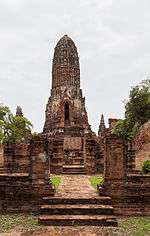Ayutthaya Historical Park
Ayutthaya Historical Park (Thai: อุทยานประวัติศาสตร์พระนครศรีอยุธยา (Pronunciation)) Well renowned as the old capital city with the longest history of Thailand, Phra Nakhon Si Ayutthaya lasted for 417 years through the reign of 33 kings. Through these golden ages, the ancestors had left behind a wide array of priceless heritage, ranging from architecture, historical sites, archeological finds, art objects to cultural identity. Stretching across the 3,000-rai plot of land, Fine Arts Department begun the conservation for archeological sites of Phra Nakhon Si Ayutthaya under the Ayutthaya Historical Park Project in 1982. Later in 1991, the Ayutthaya Historical Park was declared as a UNCESCO World Heritage Site, along with the Sukhothai Historical Park, Si Satchanalai Historical Park and Kamphaeng Phet Historical Park, by the United Nation Educational, Scientific and Cultural Organization (UNESCO).
| UNESCO World Heritage Site | |
|---|---|
 Plan of Ayutthaya historical park | |
| Location | Ayutthaya, Thailand |
| Criteria | Cultural: iii |
| Reference | 576 |
| Inscription | 1991 (15th session) |
| Area | 289 ha |
| Coordinates | 14°20′52″N 100°33′38″E |
 Location of Ayutthaya Historical Park in Thailand | |
Ayutthaya Historical Park consists of 425 unearthed archaeological sites, which are located within and outside the city wall, with main highlights as follows:
The Royal Chapel, situated on the north of Wat Phra Si Sanphet on the bank of Lopburi River, is currently apparent in ruins, which were once the foundation of throne halls. Visitors will observe historical sites that were damaged by the great fire that broke out during the second defeat of Ayutthaya Kingdom. The Royal Chapel was built in the era of King Borom Trai Lokkanat as he had granted a conversion of the royal house built during the reign of King Ramathibohi I (King U-Thong) into Wat Phra Si Sanphet.
Wat Phra Si Sanphet is considered the most important temple of Ayutthaya Kingdom. Originally, King Ramathibohi I (King U-Thong) commanded the construction of the royal house in this area in which King Borom Trai Lokkanat had later granted the use of residence as the royal temple with the aim to facilitate the operations of important royal ceremonies and merit making ceremonies.
Wat Ratchaburana was founded by King Borom Rachathirat II (Chao Sam Phraya) in 1424 on the area used as the cremation site for Chao Ai Phraya and Chao Yi Phraya, his two elder brothers, who fought and died for a throne.
Vihara Phra Mongkol Bophit houses one of Thailand’s largest bronze Buddha images. The site is distinct with the early Ayutthaya architectural style. In 1956, Field Marshal Plaek Phibunsongkhram, the then prime minister, had commanded the renovation into the current condition.
Furthermore, there are other archaeological sites within the Ayutthaya Historical Park, such as Wat Mahathat, Wat Phra Ram, Wat Chaiwatthanaram, Wai Yai Chai Mongkhon, Wat Phanan Choeng, Wat Thammikarat, etc.
Park sites
- Wat Chaiwatthanaram
- Wat Kasatrathiraj
- Wat Kudi Dao
- Wat Lokayasutharam
- Wat Mahathat
- Wat Phanan Choeng
- Wiharn Phra Mongkhon Bopit
- Wat Phra Ram
- Wat Phra Sri Sanphet
- Wat Ratchaburana, Ayutthaya
- Wat Yai Chai Mongkhon
- Phra Chedi Suriyothai
- Ayutthaya historical Study Centre
- Japanese Settlement
- Wat Phu Khao Thong
- Elephant Camp [the camps are very abusive to the elephants and torture them visit Boon Lotts Elephant Sanctuary for more information]
UNESCO World Heritage Site

In 1991, part of Ayutthaya Historical Park was declared a UNESCO World Heritage Site under criteria III as an excellent witness to the period of development of a true national Thai art. The inscribed area covered only 289 ha of the central and southwestern parts of Ayutthaya Island; as a result, only certain groups of historical sites are under UNESCO protection. The sites including Wat Ratchaburana, Wat Mahathat, Wat Phra Sri Sanphet, Wat Phra Ram, and Wiharn Phra Mongkhon Bopit. The sites that are not part of World Heritage sites are the sites beyond Ayutthaya Island, for example, Wat Yai Chai Mongkon, Wat Phanan Choeng, Wat Chaiwatthanaram, and Wat Phu Khao Thong.
Gallery
 Wat Phra Sri Sanphet
Wat Phra Sri Sanphet Wat Mahathat
Wat Mahathat- Wat Ratchaburana
 Wat Yanasen
Wat Yanasen Wat Phra Ram
Wat Phra Ram Wat Thammikarat
Wat Thammikarat Wat Phra Sri Sanphet
Wat Phra Sri Sanphet The head of Buddha, Wat Mahathat
The head of Buddha, Wat Mahathat
 Headless statues
Headless statues Ayutthaya Historical Park
Ayutthaya Historical Park
See also
- Ayutthaya kingdom
- Ayutthaya (city)
Notes
a The city was founded on Friday, the 6th day of the waxing moon of the 5th month, 1893 Buddhist Era, corresponding to Friday, 4 March 1351 Common Era, according to the calculation of the Fine Arts Department of Thailand.[1]
References
- Rotchanaratha, Wina, ed. (1999). Prachum Phongsawadan Chabap Kanchanaphisek Lem Nueng ประชุมพงศาวดาร ฉบับกาญจนาภิเษก เล่ม ๑ [Golden Jubilee Collection of Historical Archives, Volume 1] (in Thai). Bangkok: Fine Arts Department of Thailand. p. 211. ISBN 9744192151.
External links
| Wikimedia Commons has media related to Ayutthaya Historical Park. |

- Thai Tourism Authority: official Ayutthaya historical park website
- Ayutthaya.net: Ayutthaya Attractions
- UNESCO: Official Ayutthaya website